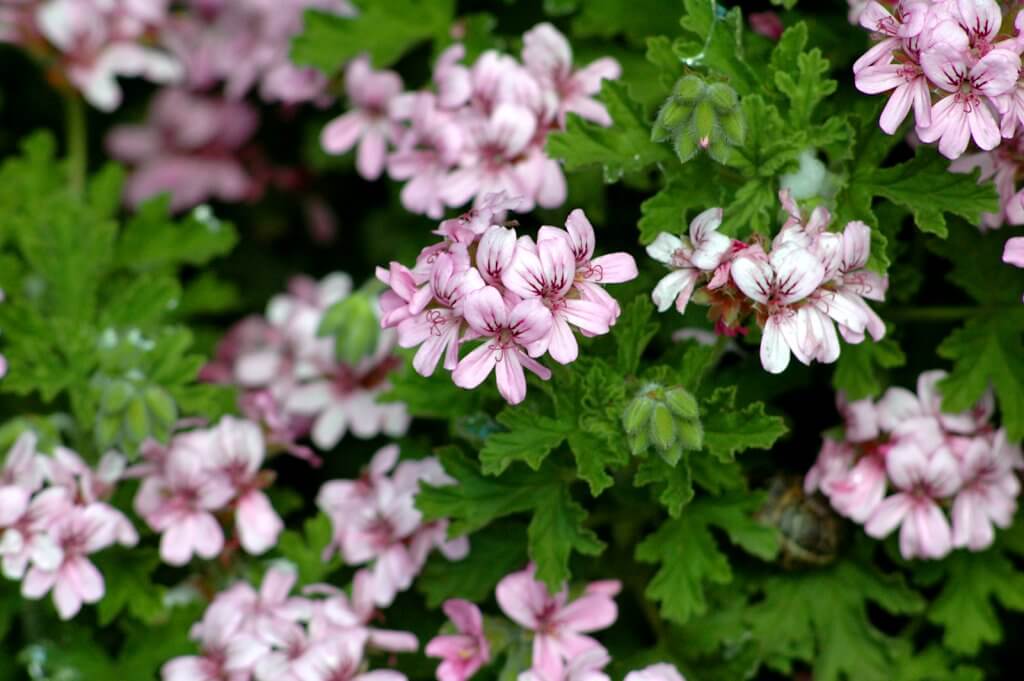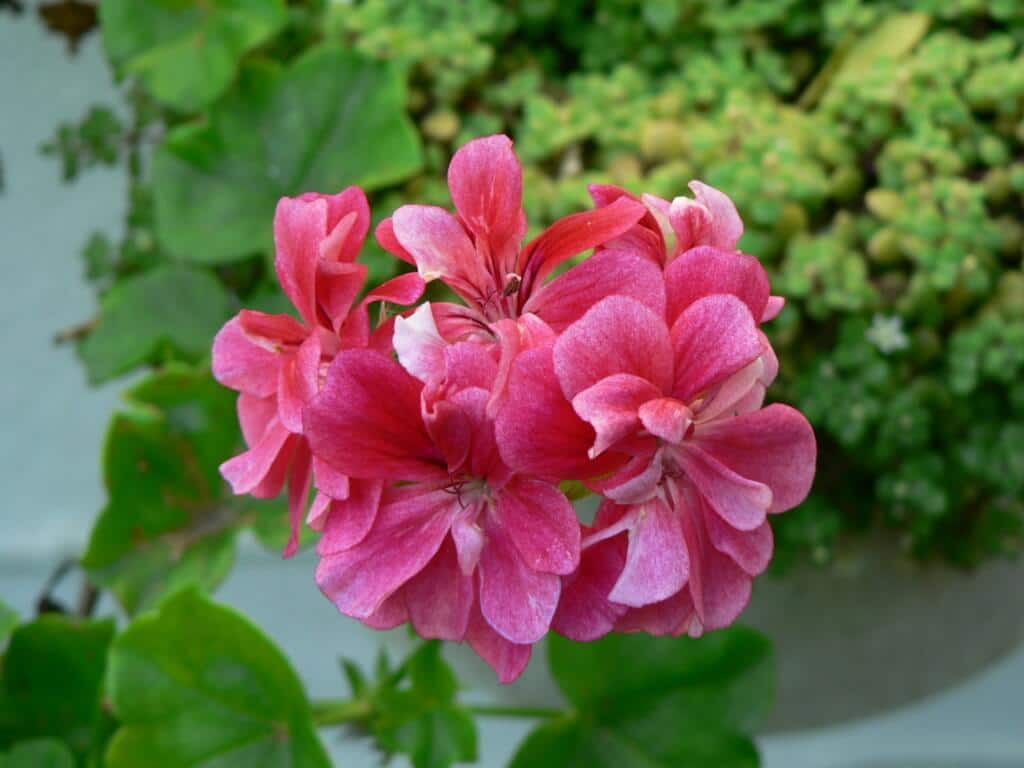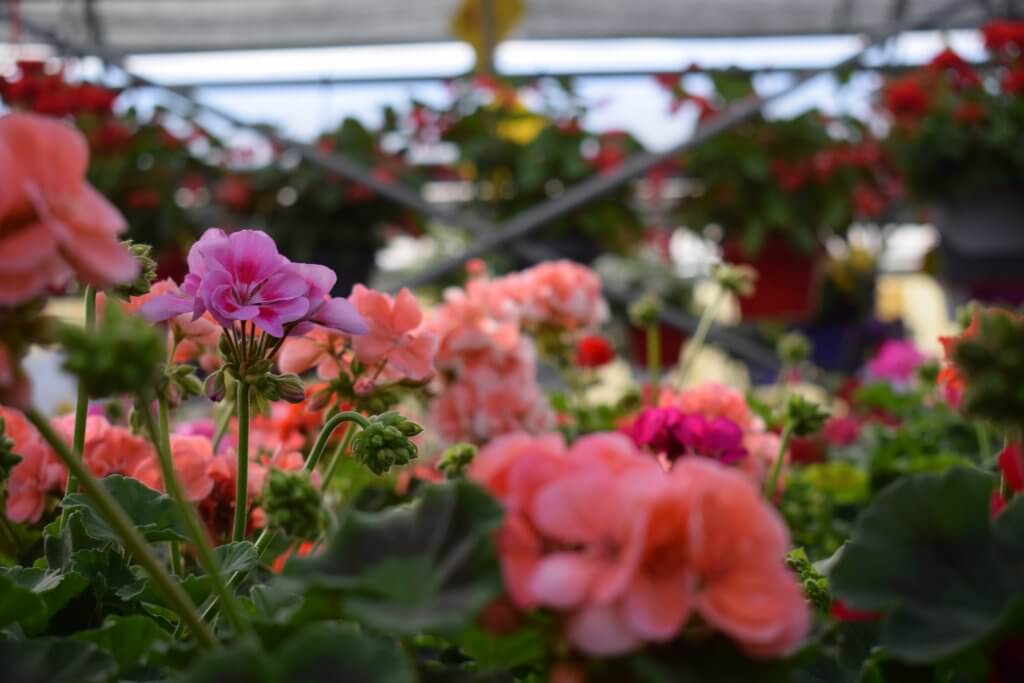Geraniums (Pelargonium) are a group of perennial, flowering plants. You may also know them by the names pelargoniums or storkbills. The wild varieties are native to temperate and some tropical regions, including South Africa. However you will now find them growing in suitable, temperate climates around the World. Particularly in cultivated gardens and as house plants.
Over 200 species of geraniums can be discovered throughout the World. Typically you will see long, lobed leaves creating a bushy base. Long stems will emerge from the plant during its flowering season with brightly colored flower heads. Pink, purple, white, orange and red hues can be found, with flowers forming small branched clusters. Their flowers remain for a long period of time, which is the reason for their popularity as bedding plants.

Cultivation and History of Geraniums
Any soil type is generally suitable for geraniums, as long as it drains well. Plant them within an area that receives partial sun and shade throughout the day. They are usually quite heat resistant and can survive for long periods without water, however a frost is likely to kill the plant.
Many geraniums are cultivated for their ornamental value and beauty. So it is easy to browse the wide variety of species on offer at a local garden center.
You can also propagate geraniums from cuttings. Simply make a cutting above a node where leaves are present and remove any flowers or buds. Next, use newspaper to wrap the stem and place it in a shaded area to allow the cut end to seal. Then gently push the stem into a moist pot of rooting medium and store it within a warm, shaded place for 48 hours. Finally, place the cutting into indirect sun and allow it to grow and mature.
Toxicity
Geraniums are not considered toxic to humans. Limited research has been conducted on the long term effects of taking geranium and dosage amounts. So you must take care when using it as a herbal remedy. If you are pregnant or breast feeding you should avoid taking geranium. It has a history of being used to treat heavy menstruation. Its unknown astringent properties could cause harm to an infant. The essential oil must never be consumed and it must also not be applied directly to the skin without being diluted first.

Uses
Culinary uses of Geraniums
The leaves of geraniums have a light, floral, citrus aroma that you can be use to create herbal teas. Different geraniums have different flavors and aromas, so it can be fun to experiment with different varities. Some have strong hints of lemon, others minty and some rose flavored. The flowers of Sweet Geranium are edible, so you can use them as a decorative garnish on dishes. You can add the essential oil extracted from geraniums to cakes, pastries and other baked goods. However the quantity must be small, this is because high dosage amounts may have a toxic effect on the body.
Products created with Geraniums
Essential oils created using geraniums are very popular in apothecary and specialist herbal shops. You can use the oil to scent many products, from candles to bath salts. You can distill the oil from geraniums yourself at home. Fill a jar with cut and bruised flower heads and leaves and an unscented oil, like jojoba. Stir the mixture and allow it to sit for up to two weeks. Strain the leaves from the mixture and use the oil as you wish. You can also use the dried flowers to create your own beautifully scented potpourri.

Medicinal uses of Geraniums
Geraniums have a long history of being used as a herbal remedy. It was used to treat minor wounds, cuts, coughs and colds. Recent research has concluded that geranium oil possess antiseptic and antibacterial properties. You may see it included in products that topically treat acne and skin infections.
Geranium oil is extremely popular within aromatherapy, as it is can reduce stress, fatigue and anxiety. It can also improve cognitive function and balance hormones and emotions.
Did you know…
Geraniums (or Pelargonium) can be confused with another common plant. The commonly called cranesbill has a botanical name of Geranium. To help with telling the plants apart you can look at the petal structure. True cranesbill geraniums will have only 5 petals. Pelargonium geraniums will have 7 petals, with 2 upper petals sitting above the lower 5.
Conclusion
Geraniums can make an extremely attractive border and summer bedding plant within your garden. Their eye catching colors and variety of species will leave you wondering exactly which plants to choose. If you have the space, try experimenting with different colors and varieties to create your own fragrant herbal teas or perfumes.
—————Written by Hannah Sweet
Hannah is a freelance writer and graphic designer from the UK. With a penchant for travelling, photography and all things botanical, she enjoys writing about a wealth of topics and issues, from conservation and slow living, to design and travel. Learn more about her writing and design services at www.sweetmeanders.co
Many of our readers find that subscribing to Eat The Planet is the best way to make sure they don't miss any of our valuable information about wild edibles.
See our privacy policy for more information about ads on this site






